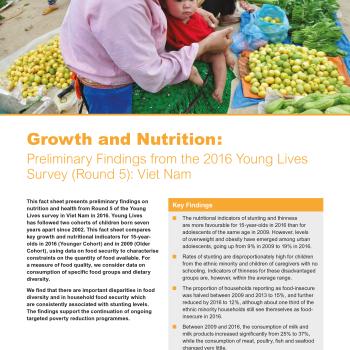Publication Information

Round 5 Longitudinal Growth and Nutrition Fact Sheet
This fact sheet presents preliminary findings on nutrition and health from Round 5 of the Young Lives survey in Viet Nam in 2016. Young Lives has followed two cohorts of children born seven years apart since 2002. This fact sheet compares key growth and nutritional indicators for 15-year-olds in 2016 (Younger Cohort) and in 2009 (Older Cohort), using data on food security to characterise constraints on the quantity of food available. For a measure of food quality, we consider data on consumption of specific food groups and dietary diversity. We find that there are important disparities in food diversity and in household food security which are consistently associated with stunting levels. The findings support the continuation of ongoing targeted poverty reduction programmes
Key Findings:
The nutritional indicators of stunting and thinness are more favourable for 15-year-olds in 2016 than for adolescents of the same age in 2009. However, levels of overweight and obesity have emerged among urban adolescents, going up from 9% in 2009 to 19% in 2016.
Rates of stunting are disproportionately high for children from the ethnic minority and children of caregivers with no schooling. Indicators of thinness for these disadvantaged groups are, however, within the average range.
The proportion of households reporting as food-insecure was halved between 2009 and 2013 to 15%, and further reduced by 2016 to 12%, although about one third of the ethnic minority households still see themselves as food-insecure in 2016.
Between 2009 and 2016, the consumption of milk and milk products increased significantly from 25% to 37%, while the consumption of meat, poultry, fish and seafood changed very little.
The indicators on stunting, food security, and dietary diversity all show a clear similarity in the patterns of inequality between the same sets of disadvantaged and advantaged groups.

Round 5 Longitudinal Growth and Nutrition Fact Sheet
This fact sheet presents preliminary findings on nutrition and health from Round 5 of the Young Lives survey in Viet Nam in 2016. Young Lives has followed two cohorts of children born seven years apart since 2002. This fact sheet compares key growth and nutritional indicators for 15-year-olds in 2016 (Younger Cohort) and in 2009 (Older Cohort), using data on food security to characterise constraints on the quantity of food available. For a measure of food quality, we consider data on consumption of specific food groups and dietary diversity. We find that there are important disparities in food diversity and in household food security which are consistently associated with stunting levels. The findings support the continuation of ongoing targeted poverty reduction programmes
Key Findings:
The nutritional indicators of stunting and thinness are more favourable for 15-year-olds in 2016 than for adolescents of the same age in 2009. However, levels of overweight and obesity have emerged among urban adolescents, going up from 9% in 2009 to 19% in 2016.
Rates of stunting are disproportionately high for children from the ethnic minority and children of caregivers with no schooling. Indicators of thinness for these disadvantaged groups are, however, within the average range.
The proportion of households reporting as food-insecure was halved between 2009 and 2013 to 15%, and further reduced by 2016 to 12%, although about one third of the ethnic minority households still see themselves as food-insecure in 2016.
Between 2009 and 2016, the consumption of milk and milk products increased significantly from 25% to 37%, while the consumption of meat, poultry, fish and seafood changed very little.
The indicators on stunting, food security, and dietary diversity all show a clear similarity in the patterns of inequality between the same sets of disadvantaged and advantaged groups.

